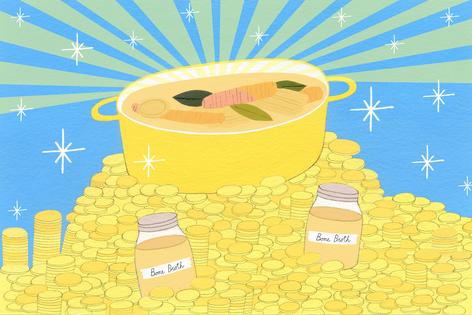The Kitchn: Bone broth is here to stay
As I worked my way through buzzing halls of an organic and natural foods trade show last year, a suited man pressed through the crowd, bellowing into his smartphone. "It's bone broth," he hollered urgently and almost feverishly as though he had struck gold or was about to. "Bone broth everything!"
I gritted my teeth and wondered ruefully (and perhaps wistfully too) if bone broth had finally reached its peak.
A stock by any other name
Bone broth, intended for sipping and made by slowly simmering bones in water that's been acidified by vinegar or wine until they break down, is anything but new. As soon as people could craft a pot in which to boil water, they boiled bones for broth. Its savory steam, infused with herbs and vegetable scraps, perfumed kitchens for centuries where home cooks lovingly doled out mugs of broth to cure a cold, to fortify their families against bitter winters, and to provide appetizing sustenance before a larger meal.
The term "bone broth" appears in the medical and anthropological literature of the 1930s. Victorian-era cookbooks maintain sections devoted to healing foods which invariably include recipes for special broths intended as first foods for babies or to nurse the ill back to health. In extensive writings, the 12th-century physician Maimonides heralded the curative properties of broth made from spent laying hens; and archaeologists have unearthed clay pots still filled with beef bones buried deep in Chinese soil for thousands of years.
So ingrained was bone broth in the kitchen that it even gives us the word "restaurant" after an 18th-century Parisian broth seller named Boulanger opened an eating establishment, promising restorative broths (or "restaurants") fit for the gods.
That a traditional, time-worn staple of kitchens worldwide can be reborn as a "trendy" health food bears witness to just how far American home cooking had wandered from its made-from-scratch path before the local and real foods movements revived the practice of making bone broths at home, and the burgeoning ancestral health community championed it.
Why bone broth tastes so good
A traditionally prepared bone broth is wonderfully savory, a flavor that comes from its high level of glutamine, an amino acid that increases in broth the longer it cooks. It's glutamine that gives long-simmered bone broths those irresistible umami notes that make bone broth so marvelously adaptable -- perfect for sipping on its own, for making soups and sauces, for seasoning risottos, and for braising vegetables.
...continued







